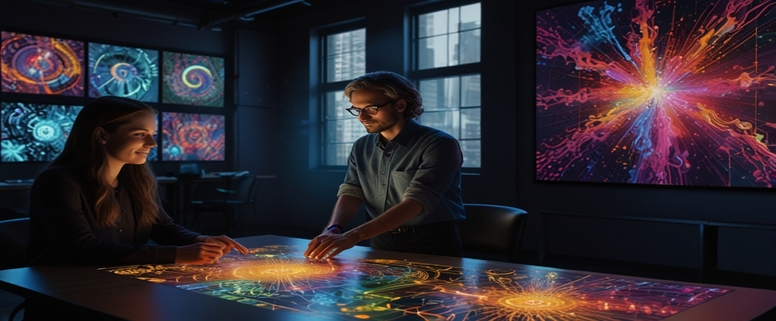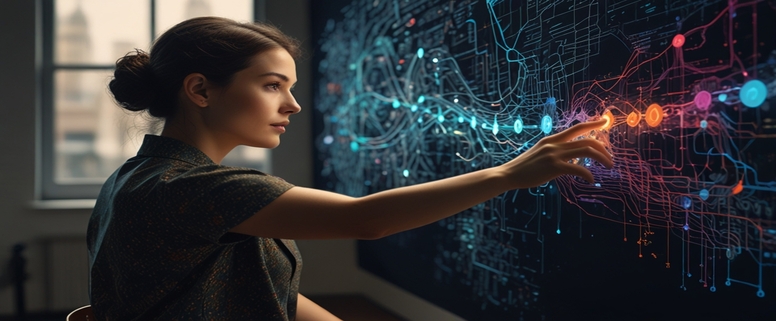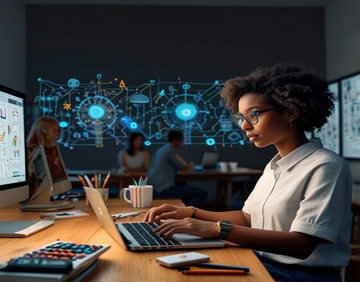Introduction: The New Creative Renaissance
We stand at the threshold of a profound transformation in human creative capability. Throughout history, productive creativity—whether artistic, intellectual, or practical—has been constrained by access to specialized knowledge, tools, training, and resources. These constraints have limited who could participate in certain forms of creation, leading to vast inequalities in creative opportunity and expression.
Artificial intelligence is fundamentally changing this equation. The democratization of productivity through AI tools represents one of the most significant expansions of human creative potential since the printing press revolutionized access to knowledge. Today's AI systems are making sophisticated creative and intellectual capabilities available to virtually anyone with an internet connection, regardless of formal training, specialized expertise, or institutional affiliation.
This democratization isn't just about making existing activities more efficient—it's about qualitatively transforming who can participate in creative production and how they can express themselves. From visual artists using generative AI to explore new aesthetic possibilities, to non-programmers building functional applications through natural language instructions, to learners accessing personalized education without institutional gatekeepers—AI is redistributing creative power in ways that were difficult to imagine even a decade ago.
Drawing from my experiences developing educational AI tools and exploring the intersection of technology and human potential, this article examines how AI is democratizing productivity, the specific capabilities being unlocked, and the crucial balance between technological empowerment and human agency in this new creative landscape.
The Democratization Revolution
The democratization of productivity through AI represents a fundamental shift in who can create what, with which tools, and how these creations can be shared and built upon. This transformation operates through several key mechanisms:
Key Mechanisms of Democratization
Expertise Simulation
AI systems can simulate aspects of specialized expertise, allowing individuals without formal training to access capabilities previously requiring years of study or practice. This doesn't replace deep expertise but extends basic capabilities to a much wider population.
Cost Collapse
Tasks that once required expensive equipment, materials, or human specialists can now be accomplished with AI tools at a fraction of the cost, often through subscription models or even free services.
Interface Simplification
Natural language interfaces and intuitive visual controls replace specialized technical languages and complex tool manipulation, dramatically lowering barriers to entry for sophisticated creation.
Location Independence
Cloud-based AI tools remove geographical constraints, allowing participation regardless of physical location or proximity to creative centers.
Personalization at Scale
AI enables personalized assistance tailored to individual needs, learning styles, and goals, providing customized support that would be prohibitively expensive in traditional human-to-human contexts.
The implications of this democratization extend far beyond individual convenience. When creative tools become universally accessible, we see a fundamental redistribution of creative opportunity and the potential for much greater diversity in who contributes to our cultural, intellectual, and technological development. Perspectives, ideas, and approaches that might never have found expression in traditional systems now have pathways to development and sharing.
This democratization isn't without precedent. The personal computer revolution, the internet, and smartphone technology each represented similar expansions of access to creative tools. However, current AI systems represent a qualitative leap beyond these previous technologies in their ability to simulate human-like cognitive capabilities rather than simply providing connectivity or computational power.

Creative Capabilities Unleashed
The democratization of productivity through AI is particularly visible in creative domains traditionally requiring specialized training, talent, or resources. These tools are not merely making existing creative processes more efficient but fundamentally transforming who can participate and what they can create:
Examples of Creative Capabilities Unleashed
Visual Arts
Today's image generation AI tools allow individuals with no formal artistic training to create sophisticated visual content by describing their ideas in natural language. This capability transforms the relationship between imagination and execution—ideas that might have remained unrealized due to technical limitations can now be visualized, refined, and shared.
Written Expression
AI writing assistants have dramatically expanded who can produce clear, structured, and effective written communication. These tools help individuals overcome barriers ranging from language proficiency limitations to dyslexia to simple uncertainty about structure and organization.
Music and Audio
Music creation, once requiring extensive instrumental training or expensive studio equipment, has been transformed by AI tools that can generate compositions, accompany performances, produce realistic instrumental sounds, and even create vocal performances in various styles.
These tools allow musical expression for individuals who might never have had access to traditional music education or performance opportunities. A person with a melody in mind but no instrumental training can now bring that musical idea to life with AI assistance.
For trained musicians, these same tools extend creative possibilities, allowing experimentation with instrumentation and arrangements that might otherwise be inaccessible, serving as collaborators that enhance rather than replace human musicality.
The democratization of these creative capabilities doesn't eliminate the value of deep expertise or dedicated practice—masterful human creators continue to produce work of distinctive quality and originality. What changes is that creation is no longer binary (either you can or cannot create in a given medium) but becomes a spectrum where anyone can participate at some level while still acknowledging the distinctive contributions of dedicated practitioners.
Learning Without Limits
Perhaps the most profound democratization through AI comes in the domain of learning itself. Access to effective education has traditionally been constrained by geographical location, economic resources, institutional admission processes, and individual learning differences. AI is fundamentally changing this landscape through several mechanisms:
Mechanisms of Learning Democratization
Personalized Learning Pathways
AI educational tools can adapt content, pacing, and presentation to individual learning styles, prior knowledge, and specific needs. This personalization—once available only through expensive individual tutoring—becomes accessible to anyone with an internet connection.
Expert Guidance On Demand
AI systems can provide immediate feedback and guidance across a vast range of subjects, simulating aspects of expert mentorship that was previously available only to those with access to specialized teachers or professionals in a field.
Resource Curation and Synthesis
The overwhelming abundance of information online often creates a new barrier to learning—the challenge of finding relevant, accurate, and appropriately-leveled resources. AI tools can curate and synthesize information across sources, creating personalized learning materials that match the learner's specific needs and goals.
Global Knowledge Access
Language barriers have traditionally limited access to knowledge resources, with much of the world's educational content available only in major languages. AI translation and localization tools are rapidly breaking down these barriers, making knowledge access more equitable across linguistic and cultural differences.
The combined effect of these capabilities is a fundamental shift in who can learn what, when, and how. Learning becomes more accessible regardless of geographical location, economic resources, institutional affiliation, or individual learning differences. This doesn't eliminate all educational inequalities—access to technology itself remains uneven, and human mentorship continues to offer unique value—but it significantly expands opportunities for self-directed learning and skill development.
AI as a Collaborative Partner
The most powerful model for understanding AI's role in democratizing productivity isn't as a replacement for human creativity but as a collaborative partner that extends human capabilities. This collaborative relationship takes several forms:
Forms of Collaborative Relationship
Idea Exploration and Refinement
AI tools excel at helping humans explore the possibility space around their initial ideas, generating variations, alternatives, and extensions that might not have occurred to the human creator. This exploration isn't about replacing human ideation but expanding it—helping people consider more possibilities before committing to development paths.
Technical Implementation Support
Many creative visions remain unrealized because the technical implementation exceeds the creator's current capabilities. AI tools bridge this gap by handling technical aspects of creation while the human maintains creative direction and purpose.
Skill Development Acceleration
Rather than simply bypassing skill development, AI tools can actively accelerate learning by providing targeted feedback, demonstrations, and practice opportunities tailored to the individual's development needs.
Cognitive Load Management
Creative work often involves managing substantial cognitive load across multiple dimensions simultaneously. AI tools can handle certain aspects of this load, allowing humans to focus their cognitive resources on the dimensions where they add the most value.
This collaborative partnership model demonstrates that democratization through AI isn't about removing humans from the creative process but about extending who can participate and what they can create. The human remains central—providing purpose, judgment, and meaning—while the AI extends technical capabilities and supports skill development.
Balancing Empowerment and Agency
The democratization of productivity through AI raises important questions about the balance between technological empowerment and human agency. As these tools become more powerful and their use more widespread, several tensions emerge that require thoughtful navigation:
Tensions Between Empowerment and Agency
Creation vs. Curation
As AI systems generate more of the technical aspects of creative work, human contribution increasingly shifts toward curation, direction, and judgment. This shift raises questions about authorship, creative responsibility, and the nature of human creative contribution.
Skill Development vs. Immediate Results
When AI can instantly generate what might take years of practice to master, individuals and educational systems must consider the value of the development journey itself, not just the final product.
Personalization vs. Standardization
While AI enables unprecedented personalization of learning and creative support, this very personalization can create new challenges for shared standards, evaluation, and collaboration. When everyone has a uniquely personalized learning path or creative process, how do we maintain shared understanding and evaluation frameworks?
Dependence vs. Enhancement
As AI tools become integrated into creative and learning processes, questions arise about potential dependence versus genuine enhancement of human capabilities. How do we ensure that AI serves as a ladder for developing authentic human capacity rather than a crutch that creates dependence?
Navigating these tensions requires a nuanced approach that recognizes both the transformative potential of AI democratization and the essential value of human agency and development. Rather than choosing between technological empowerment and human capability, the challenge is designing systems and practices that optimize their integration.

The Path Forward
As we continue to develop and deploy AI tools for creative democratization, several principles can guide us toward approaches that maximize empowerment while preserving meaningful human agency:
Principles for AI-Enhanced Creativity
Transparent Augmentation
Design AI tools that clearly distinguish between human and AI contributions rather than blurring these boundaries. This transparency helps users maintain awareness of their own agency and make conscious choices about how they integrate AI assistance.
Progressive Complexity Revelation
Structure AI tools to reveal complexity progressively as users develop skill and understanding, rather than permanently hiding it. This approach uses AI as a scaffold that can gradually be removed as the human develops capability.
Creativity Support Research
Invest in research specifically focused on how AI tools can enhance human creativity and agency rather than simply automating or replacing creative processes. This emerging field examines the cognitive, social, and technical dimensions of human-AI creative collaboration.
Ethical and Inclusive Design
Ensure that AI creative tools are designed with diverse user needs in mind and with careful attention to ethical implications. This includes considerations of data bias, attribution and ownership, accessibility, and cultural sensitivity.
By following these principles, we can develop approaches to AI-empowered creativity that genuinely democratize capability while still preserving and enhancing meaningful human agency and development.
Conclusion: Universal Creativity, Human Purpose
The democratization of productivity through AI represents one of the most significant expansions of human creative potential in history. By making sophisticated creative and intellectual capabilities accessible regardless of formal training, specialized expertise, or institutional affiliation, these technologies are redistributing creative power and opportunity in transformative ways.
This democratization isn't about replacing human creativity but extending who can participate and what they can create. The most powerful model is one of collaboration, where AI handles aspects of technical implementation while humans provide purpose, judgment, and meaning. This collaboration enables individuals to express ideas that might otherwise have remained unrealized due to technical barriers.
The tools we're building today will shape not just what people can create but how they understand their own creative potential and agency. By designing these tools thoughtfully—with attention to transparency, skill development, and human purpose—we can ensure that AI serves as a ladder for human development rather than a replacement for human capability.
The democratization of productivity through AI offers unprecedented opportunities for diverse voices, perspectives, and ideas to find expression. People previously excluded from certain forms of creation now have pathways to participation. This expanded creative diversity represents perhaps the greatest potential benefit of these technologies—a broader, richer creative landscape that includes contributions from across humanity.
As we continue developing and integrating these tools, the central question isn't whether AI will replace human creativity but how we can best design systems that genuinely empower human creative potential. The future belongs not to AI alone or to humans alone, but to thoughtful integration that preserves human purpose and agency while expanding creative possibility.
The democratization of productivity through AI is remarkable. Tools like generative AI allow individuals to create, learn, and explore in ways previously unimaginable. But this potential comes with responsibility. We must be vigilant about data integrity, ethical implementation, and ensuring these technologies serve collective human progress—not just corporate interests.





